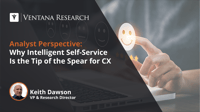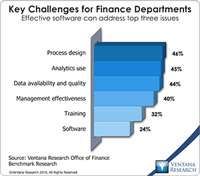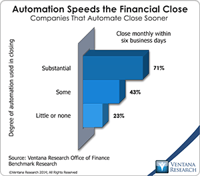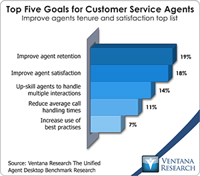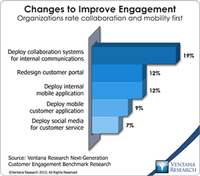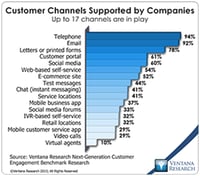Ventana Research recently announced its Market Agenda in the expertise area of Customer Experience. CX has emerged as a way for enterprises to demonstrate value and stand out in the marketplace. The technology underlying modern CX is transitioning from tools that are based on communication to those centered on data analysis and process automation. No technology has had as dramatic impact as quickly as Generative AI, which has upended the industry. It allows enterprises to build great...
Read More
Topics:
Customer Experience,
Voice of the Customer,
Self-service,
Analytics,
Contact Center,
agent management,
Customer Experience Management,
Field Service,
AI and Machine Learning
A lot of conversations around contact centers deal with automation, particularly how to balance the way humans and automated systems work together. Self-service, the front end of the customer interaction, is where practitioners get a first taste of the marvels of increasingly advanced automation. As customer expectations ramped up and labor became more costly during the pandemic, deflecting interactions away from agents took on new urgency. We continue to see impressive advances in automated...
Read More
Topics:
Customer Experience,
Self-service,
automation,
Contact Center,
Knowledge Management,
agent management,
Customer Experience Management,
Intelligent Self-Service,
Conversational AI
Organizations looking to improve the customer experience and contact center operations should closely examine the processes at work in the front-end self-service environment. Technology advancements are converging at this gateway, including artificial intelligence, chatbots and knowledge management. The front end of the customer interaction offers a greater opportunity for customer engagement than most organizations realize.
Read More
Topics:
Customer Experience,
Self-service,
Contact Center,
Knowledge Management,
Chatbots,
agent management,
Intelligent Self-Service
Ventana Research recently announced its Market Agenda in the expertise area of Customer Experience. CX has emerged as a way for organizations to demonstrate value and stand out in the marketplace. The technology underlying modern CX is transitioning from tools that are based on communication to those centered on data analysis and process automation. This allows organizations to build great experiences and reap the benefits in customer loyalty and value. It also forces companies to reckon with...
Read More
Topics:
Customer Experience,
Voice of the Customer,
CEM,
Self-service,
Analytics,
Contact Center,
agent management,
Customer Experience Management,
Field Service,
AI & Machine Learning
Our recently published Office of Finance benchmark research assesses a broad set of functions and capabilities of finance organizations. We asked research participants to identify the most important issues for a finance department to address in a dozen functional areas: accounting, budgeting, cost accounting, customer profitability management, external financial reporting, financial analysis, financial governance and internal audit, management accounting, product profitability management,...
Read More
Topics:
Mobile,
Planning,
Predictive Analytics,
ERP,
FP&A,
Office of Finance,
Reporting,
Self-service,
Budgeting,
close,
closing,
computing,
Controller,
dashboard,
Tax,
Analytics,
Business Intelligence,
Business Performance,
Cloud Computing,
Collaboration,
Financial Performance,
CFO,
Data,
finance,
Financial Performance Management,
FPM,
Microsoft Excel,
Spreadsheets
Our recent Office of Finance benchmark research demonstrates the importance of using automation to execute finance department functions. Information technology systems do at least two things very well that make better use of people’s time, and both of them can substantially improve organizational performance. First, they eliminate the need for people to do repetitive tasks, which frees them to spend time on more valuable work that requires judgment and skill. IT systems also can be programmed...
Read More
Topics:
Big Data,
Mobile,
Planning,
ERP,
FP&A,
Office of Finance,
Reporting,
Self-service,
Budgeting,
close,
closing,
computing,
Controller,
dashboard,
Tax,
Analytics,
Business Analytics,
Business Collaboration,
Business Intelligence,
Business Performance,
Cloud Computing,
Collaboration,
Financial Performance,
CFO,
Data,
finance,
Financial Performance Management,
FPM,
Microsoft Excel,
Spreadsheets
ManyWho was launched in May 2013 by two former Salesforce.com executives, Dave Norris and Steve Wood. They branded it the Cloud Workflow Company, It offers an innovative approach that allows organizations to create workflows, automatically convert them into business applications and run the apps on multiple types of devices. The key to its success lies in the second and third steps, which differentiate ManyWho from most other business process optimization vendors; the process maps that users...
Read More
Topics:
Customer Experience,
Self-service,
Operational Performance,
Business Collaboration,
Cloud Computing,
Customer & Contact Center,
Customer Service,
Call Center,
Contact Center,
CRM
When Salesforce.com began in 1999 its stated intent was “to reinvent CRM in the cloud.” In 15 years, the company has achieved much more than that, having a major impact on the way IT systems are delivered: Large numbers of vendors have followed its example to provide cloud-based systems. It added a platform as a cloud – a software development environment in the cloud – to its portfolio, introduced an apps store where many vendors sell their products and services, moved into social and mobile...
Read More
Topics:
Big Data,
Social Media,
Customer Analytics,
Customer Experience,
Customer Feedback Management,
Speech Analytics,
Self-service,
Operational Performance,
Analytics,
Business Collaboration,
Cloud Computing,
Customer & Contact Center,
Customer Service,
Call Center,
Contact Center,
Contact Center Analytics,
CRM,
Text Analytics
During this year talk has been widespread about the customer experience, which is good. What is not so good is that, according to my benchmark research into next-generation customer engagement, most companies still struggle to deliver satisfying experiences. However, the research and my discussions with users and vendors lead to some clear conclusions:
Read More
Topics:
Big Data,
Social Media,
Customer Analytics,
Customer Experience,
Customer Feedback Management,
Speech Analytics,
Self-service,
Analytics,
Cloud Computing,
Customer & Contact Center,
Customer Service,
Call Center,
Contact Center,
Contact Center Analytics,
CRM,
Text Analytics
Read More
Topics:
Big Data,
Customer Analytics,
Customer Experience,
Customer Feedback Management,
Speech Analytics,
Self-service,
Analytics,
Business Collaboration,
Cloud Computing,
Customer & Contact Center,
Customer Service,
Call Center,
Contact Center,
Contact Center Analytics,
CRM,
Text Analytics



